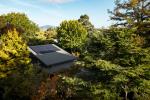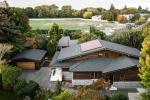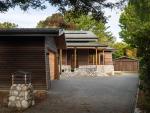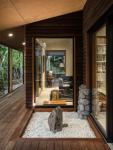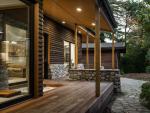The Big Cottage with a Small Footprint

Vickie and John had a vision for their new home. Taking aesthetic inspiration from the historic Californian bungalow on Fendalton Road known as the Los Angeles house and mixing in the clean Japanese/Scandinavian style known as Japandi, all while having a high performing home in terms of energy efficiency. All they needed was the right architect to bring their dream to life.
Bob Burnett Architecture, comprised of husband and wife team Bob Burnett and Shizuka Yasui, enjoys a reputation for being innovators in high performing energy efficient homes. Shizuka’s architectural training in Japan lends a strong Japanese influence over their designs, focussing on Japanese elements of flow and efficiency.
Their passion for sustainability and energy led them to develop the Superhome Movement, which aims to share knowledge about sustainable practices and create a better standard for kiwi homes. During one of the Superhomes tours of sustainable homes, Bob met Vickie and John and bonded instantly over the concept for the Big Cottage.
Starting with the exterior, the team leaned heavily into the Los Angeles house aesthetic. Sloping walls were incorporated and grounded in a heavy stone base to create a rugged atmosphere. Contrasting the heaviness on the exterior, the interior draws in natural light and warmth via large triple glazed windows and utilises warm toned wood interior materials to reflect the light. A complex warm skillion roof adds an air of spaciousness, while completing the thermal envelope to ensure the home is warm and efficient.
The warm roof was constructed of a 140mm thick layer of Cross Laminated Timber (CLT) whose raw face was used as the interior surface of the ceiling. The warm, bright timber brought a lightness to the living space inside while the thickness provided a structurally sound base for the roof to be constructed upon. Next a 90mm layer of PIR board was applied and covered by a waterproof membrane underlay, battens, and an exterior layer of steel roof tiles. Using a system of battens and counter-battens to create Above Sheathing Ventilation (ASV) which allows airflow between the underlay and the exterior tiles. This design permits the passage of air between the exterior tiles and underlay, which dries any natural moisture accumulation and equalises the temperature and humidity between the exterior of the house and the inner roof. This holistic warm roof design allows the roof to be incredibly efficient in keeping warmth inside the building while allowing for a heightened ceiling which adds to the overall visual effect of the interior.
The roof design was heavily influenced by aesthetics. “From an architectural point of view, the roof is the 5th wall. It’s just as important as the walls and it heavily influences the look and feel of the project.” Bob explains. This is why Gerard’s Senator pressed steel tile was chosen as the roofing material. Its irregular pattern and gentle mottled colouring added to the organic feel of the exterior while leaning into the inspiration of the Los Angeles house with its cedar shingle roof. A nod to Japan was incorporated with a small upturn at the edges of the roof, reminiscent of Japanese temple architecture.
Once a material was proposed for this build, the team had to ensure it held its own in terms of sustainability. Like many metals, steel is able to be recycled time and again without any degradation to its properties. Gerard’s roof tiles have a core of 0.39mm thick steel, meaning any offcuts made during the installation process and the entire roof at the end of its lifespan can be melted down and remade into new products. Gerard also enjoys ISO 14001 accreditation, giving peace of mind that an effective environmental management system is in place for the manufacture of their tiles.
The Christchurch earthquake saw a shift to lightweight roof designs. “The earthquakes changed our choices as we’d never do a heavy roof now.” Bob explains of his decision-making process, “A light roof was always going to be the way to go, in terms of earthquakes, mass is your enemy.”. The interlocking design of Gerard’s roof tile creates a strong single structural unit intrinsically safer and sturdier than loose concrete tiles of the past. The benefit of going with a steel tile roof is the reduction in building materials required to support the roof “If you’ve got a heavy roof, you’re inherently going to have to have a heavier wall structure and bracing to support the roof.” Bob says.
The overall roof design is a key element in ensuring energy efficiency and liveability in the home. The design of the Big Cottage utilises a clever roofing feature to minimise overheating in the warmer months. An engawa, a roofed verandah-like structure that wraps around the building was designed, leaning on Japanese architectural practises. “The engawa really is fundamental. It’s crucial in preventing overheating.” Bob explains “It’s actually quite easy to do a warm home, but it’s more difficult to make it so that it’s not going to be too hot in summer, and the engawa is essential in preventing that overheating by blocking the midsummer midday sun on the north side, and allowing enough sun to come in during the winter when the sun is at a lower angle.” Nestled into the engawa roof is a large skylight, positioned to allow light into the kitchen and dining area where more natural light is needed, further reducing the power demand on the home.
Additional features are peppered throughout this project such as rainwater harvesting off the roof. From a Superhome perspective, this is a must-have. “It’s so easy to do and doesn’t cost a lot, so you might as well make use of the water.” Bob says of rainwater harvesting “We’re using it as irrigation for the garden as a minimum. Then the next step is to plumb it in to flush the toilets because in the average home half the water is flushed down the toilet.” Gerard’s steel tiles are an ideal fit for this feature, as both smooth and textured finishes are safe for rainwater harvesting. Additionally, all Superhomes are outfitted with solar panels to ensure energy is being captured and utilised within the home. Gerard has an innovative bracketing system which allows solar panels to be mounted with brackets hooked under roofing panels to eliminate the need for roof penetrations which may cause degradation of the roof over time.
The project now stands completed with Vickie and John enjoying their new home. And showing their passion in furthering the education around sustainability and a better way of building, they’ve since had the annual Superhome Tour feature their home as a stop – the same tour they took before building the Big Cottage. Bob reflects on the project “It was a privilege to work on it and work with John and Vickie. They loved their house and at the end of the day that’s the ultimate reward for us.”.

